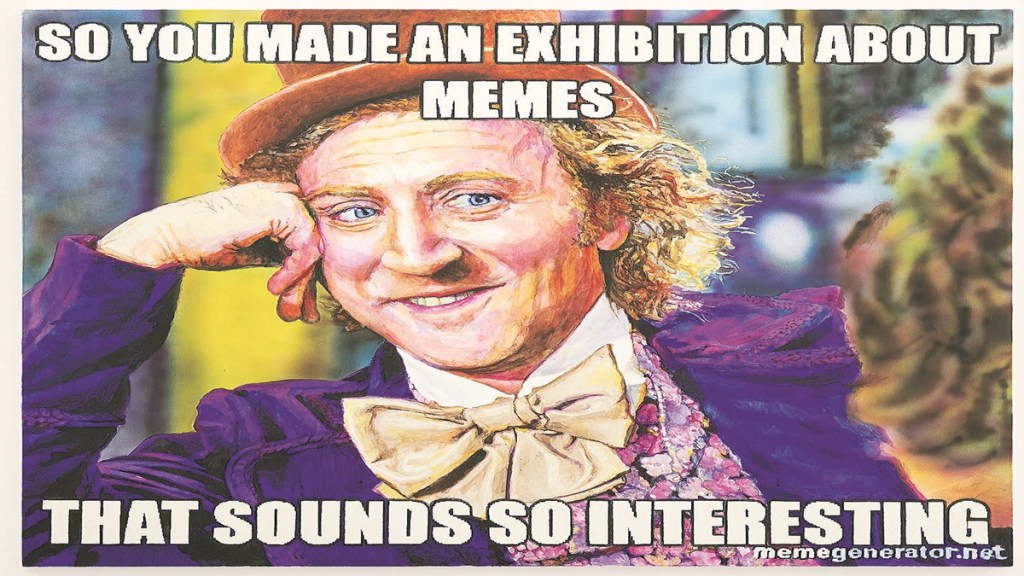For long, memes have been dismissed as fleeting jokes or humorous fragments of digital life. Yet they have also mirrored our collective psyche, politics, and emotions with uncanny precision. Now, memes have entered the gallery space as objects of serious artistic and cultural reflection.
At the Media Majlis Museum at Northwestern University in Qatar (NU-Q), the first university museum in the Arab world dedicated to exploring journalism, communication, and media, this transformation takes centrestage in an exhibition, ‘Memememememe’, on view until December 4.
A new lens on memes
Curated by Jack Thomas Taylor and Amal Zeyad Ali, the show gathers artists from Qatar, the region, and beyond to highlight how memes serve as cultural barometers, emotional shorthand, and tools of political commentary. Organised around four themes such as mass, length, time, and volume, the exhibition examines how memes spread and measure our collective thought.
“As a university museum integrated in NU-Q’s academic mission, the Media Majlis blends scholarship, art, and media to make a fuller sense of the world we live in,” said Marwan M Kraidy, dean and CEO of Northwestern Qatar. “Memememememe takes something we encounter every day-memes-and asks us to look deeper at how they shape the way we think, connect, and communicate.”
The exhibition, in the words of the director Alfredo Cramerotti, invites visitors to pause and examine memes as “seemingly trivial fragments that profoundly shape how we perceive and navigate our world.”
Global rise of meme exhibitions
Globally, in 2021, the online humour platform 9GAG in Hong Kong opened a meme museum with memes becoming part of how people communicate. It made the visitors relive internet history in 4D. Showcasing over 100 memes, the museum featured seven themed zones centred around the ‘Troll Face,’ ‘Doge,’ ‘Disaster Girl’ and more. A ‘Meme Me’ photo booth and get a temporary tattoo at the “Memeingful Tattoo Station’ and “Beyond the Meme” sensory 4-D interactive experience were part of the show. However, the Museum of the Moving Image in New York is one of the first museums dedicated to the art, technology and social impact of film, television and digital media. It houses the nation’s largest collection of moving image artefacts, screens hundreds of films annually and offers education programmes. In the past , it has held exhibitions showcasing images of memes as well. In 2019, India, too, has seen an exhibition on meme culture as a relevant art form. A series of exhibitions, one such titled “Meme Regime 2.0”, was organised by psychology graduate and self-proclaimed artist Anuj Nakade, who has been working on memes since 2007. A picture of Doge (a Shiba Inu species of dog) on which he had pasted a chef’s hat and written ‘Onion-cut much fry wow’ in colourful text was one of his first meme artworks.
Meanwhile, the Qatar show’s centrepiece, Jeroen van Loon’s Permanent Data (2020), stretches across 12 kilometres of fibre-optic cable inscribed with both the Gutenberg Bible and thousands of YouTube comments on data loss. It poses a stark question: what survives of our digital culture in the long run? Christine Wang’s Sarcastic Willy Wonka (2020) reimagines a viral meme as an acrylic painting, questioning the absurdity of digital culture when translated into the permanence of canvas. Qatari artist Alia Leonardi’s dnd, still online, still alive (2025) uses embroidered fabric to capture internet-born coping mechanisms like bed rotting and doom scrolling. In her hands, the language of memes collides with the tactile weight of manual craft, reframing online escapism as resistance.








